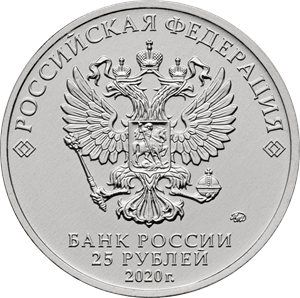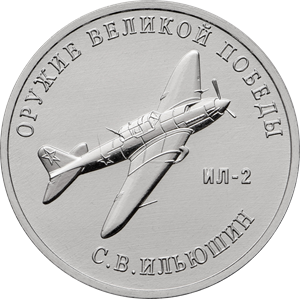Weapons Designer Sergey Ilyushin
Obverse
in the centre there is a relief image of the National Coat of Arms of the Russian Federation and over it a semicircular inscription along the rim: "РОССИЙСКАЯ ФЕДЕРАЦИЯ" (RUSSIAN FEDERATION) framed by doubled rhombuses on both sides, under the emblem, in three lines, there is an inscription: "БАНК РОССИИ" (BANK OF RUSSIA), the coin’s par value "25 РУБЛЕЙ" (25 RUBLES), and the year of issue "2020 г." (2020), and on the right there is a mint trade mark.
Reverse
a relief image of the Il-2 ground-attack aircraft and the inscription‘ИЛ-2’ (IL-2) on the right; along the rim there are the inscriptions ‘ОРУЖИЕ ВЕЛИКОЙ ПОБЕДЫ’ (WEAPONS OF THE GREAT VICTORY) at the top and ‘С.В. ИЛЬЮШИН’ (SERGEY ILYUSHIN) at the bottom.
Authors
Designers: E.V. Kramskaya (obverse), O.G. Shepel (reverse).
Sculptors: A.A. Dolgopolova (obverse), computer simulation (reverse).
Mint: Moscow Mint (ММД).
Edge: 180 corrugations.
Discover more
Sergey Vladimirovich Ilyushin (1894–1977) was a Soviet aircraft designer and the creator of the Il-2 armoured strike aircraft, which was deployed by the Soviet military in 1941.
The craft’s main purpose was to provide ground troops with close-in support, as well as to target enemy personnel, equipment, artillery units, communications, and surface vessels from short range. It was flown on the front lines and in the enemy’s immediate combat zones. The aircraft was required to have powerful weapons and high levels of protection from ground fire.
If the designers had merely dressed a regular plane in armour, this would have resulted in a bulky, slow, unwieldy design; that was why the Il-2 was based on an innovative solution: the armour became part of the main frame, encasing the craft’s most vital and vulnerable parts (the engine, the bomb bay, the cockpit, etc.). This unique layout improved the aircraft’s flight performance and significantly decreased its weight, making room for more powerful weapons. Its deadly efficiency, sturdy armoured hull, and remarkable resilience earned the Il-2 its ‘flying tank’ moniker.
The aircraft was initially produced in a single-seat version, in response to the requirements for its rate of climb, speed, and flight range. However, combat experience showed severe Il-2 losses, due to the lack of defensive equipment in an air space that was dominated by enemy fighter aircraft. Thus, a new version of the Il-2 was introduced in 1942; this time, the craft had two seats and a special cockpit for a gunner, meant to defend it from enemy fighters. In 1943, a modification of the two-seater with an improved engine entered mass production; engine tweaks brought the flight performance back to the single-seat version’s level.
Having played a part in all major battles from the very first days of Russia’s Great Patriotic War, the Il-2 would go down in history as one of the symbols of Victory in World War Two.


